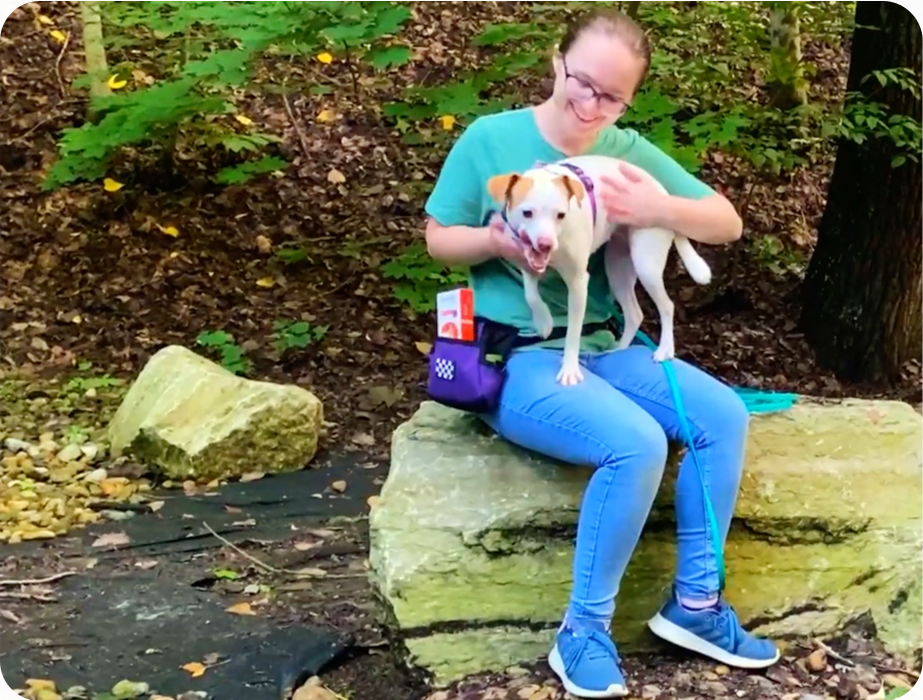
RESOURCES
Testimonials

RESOURCES
Testimonials
See the difference BRAVECTO makes for vets and pet parents
See the difference BRAVECTO makes for vets and pet parents
Across the United States and around the world, veterinarians are recommending the 12-week* protection of BRAVECTO for dogs and cats at their clinics.1-4
Hear why pet parents love using BRAVECTO


Kaylin
Dog parent
“When it comes to [my dog’s] health and wellness I want to give her the very best. That’s why I chose the 12 week vet recommended protection of Bravecto”
Hear why veterinarians recommend BRAVECTO

“Fleas and ticks aren’t just annoying. They can cause serious health issues for your pet. Give them BRAVECTO (fluralaner) Chews for up to 12 weeks of protection.”
“I recommend BRAVECTO (fluralaner) year-round, because in most environments, it’s actually not cold enough to interrupt the flea and tick life cycle.”


“As a busy pet parent myself, I know it can be hard to remember to give prevention every month. That’s why I love the convenience of BRAVECTO (fluralaner), as it lasts nearly 3X* longer than 1 dose of monthly chews”
Hear why veterinarians recommend BRAVECTO for dogs


Dr. Tannetje Crocker
VETERINARIAN
“Fleas and ticks aren’t just annoying. They can cause serious health issues for your pet. Give them BRAVECTO (fluralaner) Chews for up to 12 weeks of protection.”
Hear why veterinarians recommend BRAVECTO for dogs


Dr. Sylvalyn Hammond
VETERINARIAN
“I recommend BRAVECTO (fluralaner) year-round, because in most environments, it’s actually not cold enough to interrupt the flea and tick life cycle.”
Hear why veterinarians recommend BRAVECTO for dogs


Dr. Molly Brinkmann
VETERINARIAN
“As a busy pet parent myself, I know it can be hard to remember to give prevention every month. That’s why I love the convenience of BRAVECTO (fluralaner), as it lasts nearly 3X* longer than 1 dose of monthly chews.”

BRAVECTO for Dogs
DOGS
Find out where you can fetch
BRAVECTO today!

BRAVECTO for Cats
CATS
Pounce on the latest BRAVECTO for cats deals!
BRAVECTO is available by prescription only.
BRAVECTO is available by prescription only.
*BRAVECTO kills fleas, prevents flea infestations. BRAVECTO (fluralaner) Chews for Dogs kills ticks (black-legged tick, American dog tick, brown dog tick, and Asian longhorned tick) for 12 weeks. BRAVECTO Chews also kills lone star ticks for 8 weeks. BRAVECTO (fluralaner topical solution) for Dogs kills ticks (black-legged tick, American dog tick, and brown dog tick) for 12 weeks. BRAVECTO Topical Solution for Dogs also kills lone star ticks for 8 weeks. BRAVECTO (fluralaner topical solution) for Cats kills ticks (black-legged tick and Asian longhorned tick) for 12 weeks. BRAVECTO Topical Solution for Cats also kills American dog ticks for 8 weeks.
References
1. BRAVECTO Chew for Dogs [prescribing information]. Rahway, NJ: Merck Animal Health; 2014. 2. BRAVECTO Topical Solution for Dogs [prescribing information]. Rahway, NJ: Merck Animal Health; 2016. 3. BRAVECTO Topical Solution for Cats [prescribing information]. Rahway, NJ: Merck Animal Health; 2016. 4. Lavan RP, Armstrong R, Normile D, Zhang D, Tunceli K. J Vet Sci Technol. 2017;8:439.
Important Safety Information
Important Safety Information
BRAVECTO (fluralaner) Chews for Dogs: The most commonly reported adverse reactions include vomiting, lethargy, diarrhea, anorexia and pruritus. In some cases, adverse events have been reported following use in breeding females. BRAVECTO Chews has not been shown to be effective for 12-weeks’ duration in puppies less than 6 months of age. BRAVECTO Chews is not effective against lone star ticks beyond 8 weeks of dosing. Indicated for dogs 6 months of age and older. BRAVECTO 1-MONTH (fluralaner) Chews: The most commonly reported adverse reactions include itching, diarrhea, vomiting, decreased appetite, elevated ALT, lethargy, and weight loss. Not effective against lone star ticks in puppies less than 6 months of age. Indicated for dogs 8 weeks of age and older. BRAVECTO (fluralaner topical solution) for Dogs: The most commonly reported adverse reactions include vomiting, hair loss, diarrhea, lethargy, decreased appetite, and moist dermatitis/rash. BRAVECTO Topical Solution for dogs has not been shown to be effective for 12-weeks’ duration in puppies less than 6 months of age. BRAVECTO Topical Solution for Dogs is not effective against lone star ticks beyond 8 weeks of dosing. For topical use only. Avoid oral ingestion. Indicated for dogs 6 months of age and older. BRAVECTO QUANTUM (fluralaner for extended-release injectable suspension) for Dogs: The most commonly reported adverse reactions in a US field study included lethargy, decreased appetite, vomiting, diarrhea, elevated liver enzymes and pruritus. BRAVECTO QUANTUM is not effective against lone star ticks beyond 8 months of dosing. Indicated for dogs 6 months of age and older.
BRAVECTO (fluralaner topical solution) for Cats: The most commonly reported adverse reactions include vomiting, itching, diarrhea, hair loss, decreased appetite, lethargy, and scabs/ulcerated lesions. BRAVECTO Topical Solution for Cats is not effective against American dog ticks beyond 8 weeks of dosing. BRAVECTO Topical Solution for Cats has not been shown to be effective for 12-weeks’ duration in kittens less than 6 months of age. The safety of BRAVECTO Topical Solution for Cats have not been established in breeding, pregnant and lactating cats. For topical use only. Avoid oral ingestion. Indicated for cats 6 months of age and older. BRAVECTO PLUS (fluralaner and moxidectin topical solution) for Cats: The most commonly reported adverse reactions include vomiting, hair loss, itching, diarrhea, lethargy, dry skin, elevated ALT, and hypersalivation. BRAVECTO PLUS has not been shown to be effective for 2 months in kittens less than 6 months of age. Use with caution in cats that are heartworm positive. The effectiveness of BRAVECTO PLUS to prevent heartworm disease after bathing or water immersion has not been evaluated. The safety of BRAVECTO PLUS have not been established in breeding, pregnant and lactating cats. Indicated for cats 6 months of age and older.
All BRAVECTO products contain fluralaner, which is a member of the isoxazoline class. This class has been associated with neurologic adverse reactions including tremors, ataxia, and seizures. Seizures have been reported in dogs receiving isoxazoline class drugs, even in dogs without a history of seizures. Use with caution in dogs with a history of seizures or neurologic disorders. Neurologic adverse reactions have been reported in cats receiving isoxazoline class drugs, even in cats without a history of neurologic disorders. Use with caution in cats with a history of neurologic disorders.




